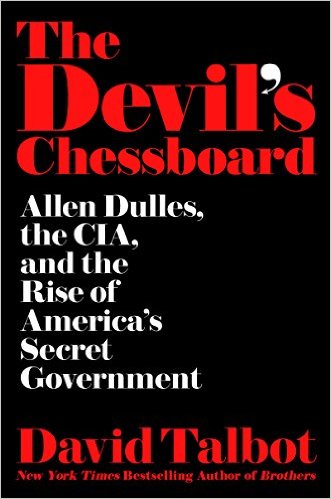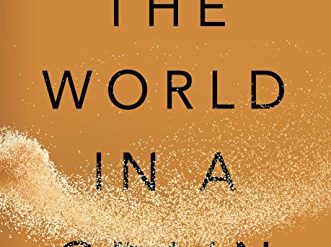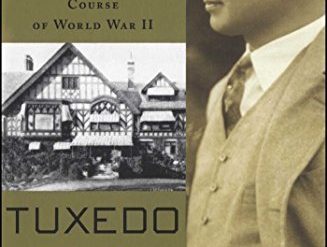
Estimated reading time: 10 minutes
If you’re familiar with mid-twentieth century American history, you’ll know the name Allen Dulles (1893-1969), who served as the director of the CIA through the tense years of the Eisenhower Administration and remained in office until John F. Kennedy fired him in 1961. Now, investigative journalist David Talbot has written an eye-opening new biography of the man.
The historical record reveals a great deal about Dulles’ career in espionage, highlighting his central role in the overthrow of the Iranian and Guatemalan governments in 1953 and 54, in the notorious MKULTRA program that administered mind-altering drugs to unwitting subjects in at least seven countries, and in the disastrous Bay of Pigs invasion of Cuba in 1961.
Recently, The Brothers, Stephen Kinzer’s dual biography of Dulles and his older brother, Secretary of State John Foster Dulles, also spotlighted the two men’s unsavory roles in funneling American capital to help build Hitler’s Germany and in the CIA’s attempts to assassinate Gamal Abdel Nasser in Egypt, Sukarno in Indonesia, Ho Chi Minh in Vietnam, Patrice Lumumba in the Congo, and Fidel Castro in Cuba.
Now, Talbot has delved more deeply into the record and taken a far more critical look at Dulles’ career in The Devil’s Chessboard: Allen Dulles, the CIA, and the Rise of America’s Secret Government. The picture that emerges is shattering.
The Devil’s Chessboard: Allen Dulles, the CIA, and the Rise of America’s Secret Government by David Talbot (2015) 652 pages ★★★★★
The most powerful men in America
During the seven years that Allen Dulles served as CIA director while his big brother was Secretary of State (1953-59), the two held sway virtually unchallenged at the helm of U.S. foreign policy. From the outset, Dwight Eisenhower was a disengaged President, favoring the golf course over the White House, and in the second term of his administration he was sidelined even more frequently by serious illness. These were the years of Sen. Joseph McCarthy’s alcohol-fueled rampage through the U.S. government, when rabid anti-Communism infected the military, academia, and the news media as well as government, and the reactionary John Birch Society built a nationwide network of chapters with more than 100,000 members.
Foster Dulles’ nuclear brinksmanship was the order of the day. And his younger brother was left free to pursue his own course at the CIA, free from scrutiny or moral scruples. In many ways, the two were the most powerful men in America. Talbot sums up the case in stark terms: “In the name of defending the free world from Communist tyranny, they would impose an American reign on the world enforced by nuclear terror and cloak-and-dagger brutality.”
The untold story of Allen Dulles
From the perspective of more than half a century, now that once-classified records are gradually being opened, it’s difficult not to conclude that Allen Dulles’ virtually unchallenged reign at the CIA was an unparalleled disaster. Previously published books and articles have brought a number of extremely unflattering revelations to light. To my knowledge, though, only David Talbot has put all the pieces together in The Devil’s Chessboard:
Aiding the Third Reich
Dulles and his brother Foster didn’t just help their law clients finance the Third Reich. Though they publicly disavowed the Nazi regime shortly before war broke out, they helped high-ranking German officials to launder looted funds through Switzerland throughout and after World War II. (Dulles headed the Office of Strategic Services, the OSS office in Bern during the war, so he was in a perfect position to continue to help his former clients and their German partners.) Talbot notes: “Dulles was more in step with many Nazi leaders than he was with President Roosevelt.”
Attempting to negotiate a separate peace with Nazi Germany
In the final stages of the war, Dulles defied Allied strategic policy and direct orders from Roosevelt. He negotiated a separate surrender of Nazi forces in Italy with the high-ranking SS general who ran the Gestapo there. When Italian partisans began closing in on the general’s hideout, Dulles organized a rescue mission. The general he snatched from the clutches of the Resistance was Heinrich “Himmler’s top troubleshooter, [who] frequently intervened to ensure the smooth efficiency of the extermination process,” the Nazis’ “Final Solution.” Nonetheless, Dulles repeatedly took action to prevent him from prosecution at the Nuremberg War Crimes Trials. As Talbot reports, “Supreme Court Justice Arthur Goldberg, who as a young lawyer served with Allen in the OSS, later declared that both Dulleses were guilty of treason.”
Protecting Nazi war criminals
The general was far from the only Nazi official whom Dulles saved from justice. Using OSS staff members who reported to him, Dulles helped smuggle an untold number of Nazi criminals to South America, the United States, and elsewhere around the world through the so-called “ratlines” established by ODESSA, the secret organization of former SS officers.
He also took part in the OSS’ Operation Paperclip, the notorious clandestine operation under which the U.S. smuggled more than fifteen hundred German scientists, engineers, and technicians to the United States to work in rocketry, biological and chemical weapons, and other fields. Many of the scientists were committed Nazis, some of them war criminals. And Dulles personally engineered the extraction of Reinhard Gehlen, the SS general who ran military intelligence for the Nazis on the Eastern Front. Gehlen, too, would have been in the dock at Nuremberg were it not for Dulles’ protection. He arranged for the Nazi spy to establish an anti-Soviet espionage network for the U.S., employing a large number of other Nazis; later, with Dulles’ support, Gehlen took over the new West German intelligence agency.
Colluding in a plot to assassinate Charles de Gaulle
Still under Dulles’ leadership in April 1961, the CIA colluded with right-wing French officers in a plot to assassinate Charles de Gaulle. The plot had been organized by the OAS, the secret paramilitary organization that attempted to prevent Algeria’s independence from France. As Talbot notes, “Allen Dulles was once again making his own [foreign] policy, this time in France.” The plot was thwarted only after President Kennedy personally warned de Gaulle’s ambassador to the U.S. that the CIA might be involved. Kennedy ordered U.S. base commanders in France to disguise the landing strips where the OAS might land its planes from Algeria, and de Gaulle mobilized the French citizenry to oppose the conspirators through strikes and other actions.
But these (and a great many other) crimes pale in comparison with Dulles’ role in the Bay of Pigs disaster and in the behind-the-scenes maneuvering that followed his termination by President Kennedy. Much of what Talbot writes about this period brings new evidence into the light of day.
The secret government meets resistance
Under President Eisenhower, the CIA directed by Allen Dulles operated with little oversight. Though the president was uncomfortable after the fact with some of the agency’s more egregious operations, he did nothing to rein in Dulles. Even the director’s brother, the Secretary of State, often found himself in the dark. Few in Congress were aware of the extent to which the CIA was manipulating events around the world. The agency operated in such secrecy that it’s possible some members of Congress didn’t even know of its existence. But the insular existence of the CIA under Dulles’ direction began to unravel following the election of John F. Kennedy.
It’s well known that the ill-fated Bay of Pigs invasion was planned during the final years of Dwight Eisenhower’s presidency and that the newly elected president only reluctantly allowed it to continue. It’s also widely believed that the invasion failed because President Kennedy refused to authorize air cover for the dissident CIA-trained Cubans of the invading force. However, as Talbot reveals, the truth is far different from the popular belief. Even an internal investigation by the CIA brought many of the facts to light.
“It is now clear that the CIA’s Bay of Pigs expedition was not simply doomed to fail, it was meant to fail. And its failure was designed to trigger the real action — an all-out, U.S. military invasion of the island.” Dulles fully expected that his hard-line allies who ran the Pentagon and staffed the National Security Council would force the new president to approve the action. Kennedy’s refusal to do so caused the distrust for him within the military and the CIA to harden into hatred. Their opposition to him grew even more bitter when he fired Dulles a few months later.
The secret government strikes back
Talbot explains, “Dulles had been deposed, but his reign continued.” He remained a darling of the establishment press, especially Henry Luce’s magazine empire and The New York Times, and the largely unchanged leadership of the CIA held frequent meetings with Dulles in his Georgetown home. Kennedy blundered by appointing Dulles ally John McCone to succeed him and leaving most of the agency’s leadership in place.
Dulles’ acolytes, Richard Helms and James Jesus Angleton, continued to dominate the CIA. Operations continued in secret, outside the oversight of the White House. As Talbot makes clear, “it was a mood of hatred and rage.” In this explosive atmosphere, Kennedy’s decision to lower the tension over Cuba following the near-catastrophe of the Cuban Missile Crisis proved fatal. “This marked the fateful turning point when the rabid, CIA-sponsored activity that had been aimed at Castro shifted its focus to Kennedy.”
CIA involvement in JFK’s assassination
In Part Three of The Devil’s Chessboard, about one-third of the book, Talbot concentrates on the evidence about CIA involvement in the assassination of JFK. Much of what he reports is based on his own interviews and on documents that came to light only decades after the event. He writes, “Those resolute voices in American public life that continue to deny the existence of a conspiracy to kill President Kennedy argue that ‘someone would have talked.’
“This line of reasoning is often used by journalists who have made no effort themselves to closely inspect the growing body of evidence and have not undertaken any of their own investigative reporting . . . The official version of the Kennedy assassination — despite its myriad improbabilities, which have only grown more inconceivable with time — remains firmly embedded in the media consciousness, as unquestioned as the law of gravity. In fact, many people have talked during the past half of a century — including some directly connected to the plot against Kennedy.”
There is now abundant evidence that high-ranking CIA officials orchestrated the murder and the cover-up that followed. Dulles himself appears to have been fully informed. Talbot reveals much of what is now known about the plot in The Devil’s Chessboard. Corroborating evidence has been published elsewhere, most notably in another remarkable book, Mary’s Mosaic, published in 2012. Two other books I’ve recently reviewed, Top Secret America and National Security and Double Government, probe the consequences of the secret government that Allen Dulles conjured into being.
About the author
David Talbot is best known as the founder and editor-in-chief of the online magazine Salon. The Devil’s Chessboard is the fourth of the nonfiction books he has written in recent years after he left work as a reporter for newspapers and magazines.
For more great reading
I’ve reviewed two other nonfiction books by David Talbot:
- By the Light of Burning Dreams: The Triumphs and Tragedies of the Second American Revolution by David Talbot and Margaret Talbot—Chronicling the incomplete second American Revolution
- Season of the Witch: Enchantment, Terror, and Deliverance in the City of Love (From the Summer of Love to the Jonestown massacre)
You’ll find this book on The 40 best books of the decade from 2010-19. It’s also one of the books I’ve included in my post, Gaining a global perspective on the world around us, one of the many good nonfiction books about national security, and it appears on Good books about racism.
For addition insight into the CIA in the 1940s and 50s, see The Quiet Americans: Four CIA Spies at the Dawn of the Cold War by Scott Anderson (Four CIA spies who helped set US policy in the 1940s and 50s).
Like to read good biography? Check out 10 great biographies. You might also be interested in seeing my post, 20 good nonfiction books about espionage.
You may enjoy browsing through 20 top nonfiction books about history. For more good books on the history of the US, see Top 20 popular books for understanding American history.
And you can always find my most popular reviews, and the most recent ones, on the Home Page.



























